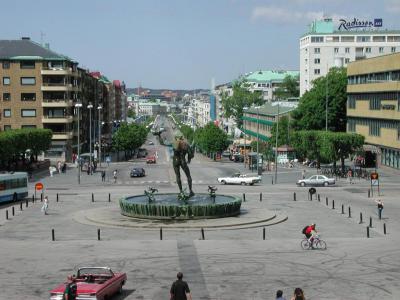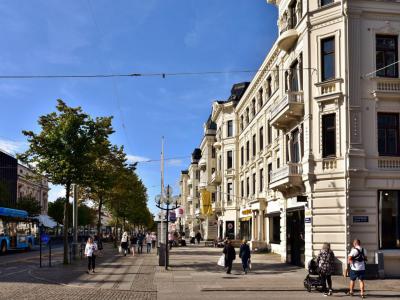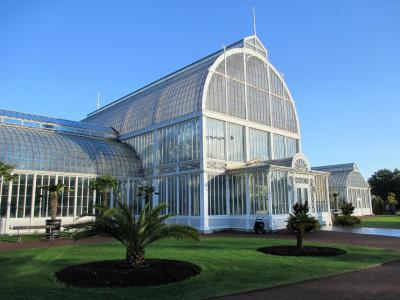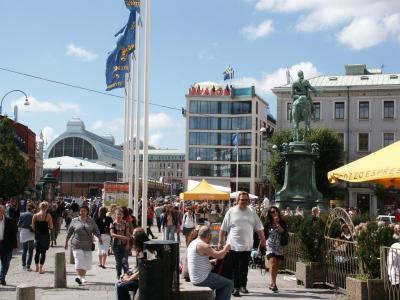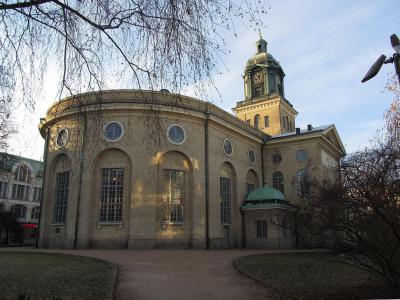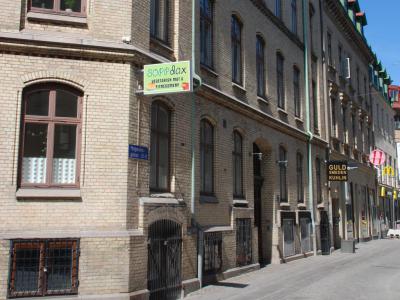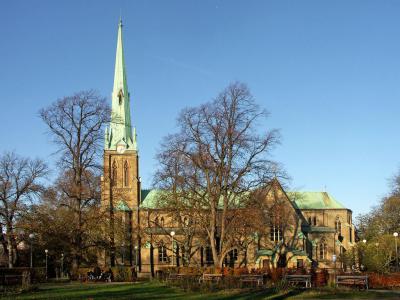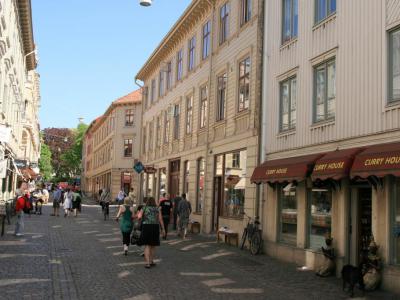Gothenburg Introduction Walking Tour (Self Guided), Gothenburg
Gothenburg is Sweden’s second-largest city. Its river-side location has been vital in its development from a trading colony to a modern, vibrant city. Today, Gothenburg is known for its culture, fabulous cuisine, and international flair.
Gothenburg was founded in 1621 by King Gustavus Adolphus. The king gave generous tax cuts to Dutch allies and encouraged German and Scottish residents to move to Gothenburg. Fishing and trade have been important industries for centuries, and the Port of Gothenburg is now the Nordic region’s biggest port.
Dutch allies helped build the town and held political power in Gothenburg. Dutch laws were followed, and the Dutch built the city walls. The walls protected the city for two centuries before they were torn down in 1810 when the city grew.
The Swedish East India Company brought the city prosperity during the 18th century. During Napoleon’s blockage, Gothenburg port became a vital stop for British goods. The port became an important transoceanic shipping link when the Gota Canal was completed in 1832. When Swedish emigration to the United States increased, Gothenburg port became Sweden's main departure point for these immigrants. Many Swedish immigrants settled in Gothenburg, Nebraska.
Gothenburg is home to two major universities. Car company Volvo was founded in Gothenburg in 1927 and is still headquartered there. Gothenburg hosts many regional events, including the Göteborg Basketball Festival, the Gothenburg Film Festival, and several music festivals.
Many city explorations begin or end at Gota Square, home of the iconic Poseiden statue. Visit the Kingsgate Avenue, Gothenburg’s main boulevard featuring fantastic shopping and exciting nightlife. Explore Gothenburg’s architectural and religious history by visiting the historical Gothenburg Cathedral, the inspiring Haga Church, and the more recent St. Andrew’s Church.
Stop by the Haga District to explore a charming cultural area with cobbled streets, boutique shops, and historic houses.
Visitors that want to partake in Gothenburg’s most enduring trade can stop by Fish Church. Fish Church offers beautiful architecture and serves the city’s freshest fish and shellfish.
Take this self-guided tour to explore Gothenburg’s most notable sights.
Gothenburg was founded in 1621 by King Gustavus Adolphus. The king gave generous tax cuts to Dutch allies and encouraged German and Scottish residents to move to Gothenburg. Fishing and trade have been important industries for centuries, and the Port of Gothenburg is now the Nordic region’s biggest port.
Dutch allies helped build the town and held political power in Gothenburg. Dutch laws were followed, and the Dutch built the city walls. The walls protected the city for two centuries before they were torn down in 1810 when the city grew.
The Swedish East India Company brought the city prosperity during the 18th century. During Napoleon’s blockage, Gothenburg port became a vital stop for British goods. The port became an important transoceanic shipping link when the Gota Canal was completed in 1832. When Swedish emigration to the United States increased, Gothenburg port became Sweden's main departure point for these immigrants. Many Swedish immigrants settled in Gothenburg, Nebraska.
Gothenburg is home to two major universities. Car company Volvo was founded in Gothenburg in 1927 and is still headquartered there. Gothenburg hosts many regional events, including the Göteborg Basketball Festival, the Gothenburg Film Festival, and several music festivals.
Many city explorations begin or end at Gota Square, home of the iconic Poseiden statue. Visit the Kingsgate Avenue, Gothenburg’s main boulevard featuring fantastic shopping and exciting nightlife. Explore Gothenburg’s architectural and religious history by visiting the historical Gothenburg Cathedral, the inspiring Haga Church, and the more recent St. Andrew’s Church.
Stop by the Haga District to explore a charming cultural area with cobbled streets, boutique shops, and historic houses.
Visitors that want to partake in Gothenburg’s most enduring trade can stop by Fish Church. Fish Church offers beautiful architecture and serves the city’s freshest fish and shellfish.
Take this self-guided tour to explore Gothenburg’s most notable sights.
How it works: Download the app "GPSmyCity: Walks in 1K+ Cities" from Apple App Store or Google Play Store to your mobile phone or tablet. The app turns your mobile device into a personal tour guide and its built-in GPS navigation functions guide you from one tour stop to next. The app works offline, so no data plan is needed when traveling abroad.
Gothenburg Introduction Walking Tour Map
Guide Name: Gothenburg Introduction Walking Tour
Guide Location: Sweden » Gothenburg (See other walking tours in Gothenburg)
Guide Type: Self-guided Walking Tour (Sightseeing)
# of Attractions: 8
Tour Duration: 2 Hour(s)
Travel Distance: 2.7 Km or 1.7 Miles
Author: DanaOffice
Sight(s) Featured in This Guide:
Guide Location: Sweden » Gothenburg (See other walking tours in Gothenburg)
Guide Type: Self-guided Walking Tour (Sightseeing)
# of Attractions: 8
Tour Duration: 2 Hour(s)
Travel Distance: 2.7 Km or 1.7 Miles
Author: DanaOffice
Sight(s) Featured in This Guide:
- Gotaplatsen (Gota Square)
- Kungsportsavenyen (Kingsgate Avenue)
- Garden Society of Gothenburg
- Kungsportsplatsen (King's Gate Square)
- Gothenburg Cathedral
- Magasinsgatan (Warehouse Street)
- Hagakyrkan (Haga Church)
- Haga Nygata Street and Haga District
1) Gotaplatsen (Gota Square)
Gota Square was founded as part of a world fair held during Gothenburg's 300th-anniversary celebrations in 1923. Gota Square is Gothenburg's central cultural hub and home to the Gothenburg Museum of Art, the Gothenburg Concert Hall, the City Library, and the Gothenburg City Theatre.
The square's impressive Poseidon statue is one of the city's favorite symbols. Poseidon is the god of the sea, storms, earthquakes and horses in Greek mythology. The statue was created by Swedish sculptor Carl Milles and inaugurated in 1931. Poseidon stars in many photos and is lit at night.
The Museum of Art was built for the 1923 Jubilee Exhibition. Terracing and natural stone stairs lead to seven high arches. The Gothenburg City Theatre opened in 1934, and the Gothenburg Concert Hall opened in 1935. The Gothenburg Public Library opened in 1967.
The square hosts an annual culture festival. During the festival, Swedish artists such as Mustasch and Teddybears perform in the square.
The square's impressive Poseidon statue is one of the city's favorite symbols. Poseidon is the god of the sea, storms, earthquakes and horses in Greek mythology. The statue was created by Swedish sculptor Carl Milles and inaugurated in 1931. Poseidon stars in many photos and is lit at night.
The Museum of Art was built for the 1923 Jubilee Exhibition. Terracing and natural stone stairs lead to seven high arches. The Gothenburg City Theatre opened in 1934, and the Gothenburg Concert Hall opened in 1935. The Gothenburg Public Library opened in 1967.
The square hosts an annual culture festival. During the festival, Swedish artists such as Mustasch and Teddybears perform in the square.
2) Kungsportsavenyen (Kingsgate Avenue)
Kingsgate Avenue is Gothenburg’s main boulevard. The design of the avenue was inspired by Vienna's Ring Road and the Champs-Elysees in Paris. The stately one kilometer avenue stretches from The Moat to Gota Square. Residents often refer to Kingsgate Avenue as simply "The Avenue."
Kingsgate Avenue was named after Kings Gate, which was replaced by a park in the 19th century. The avenue was originally a wealthy residential street. Today, Kingsgate Avenue features the Stora Teatern musical theater and many pubs, restaurants, and clubs.
Kingsgate Avenue reminds visitors of a busy London or Paris hot spot. Here, you'll find fantastic shopping and cozy dining spots. Visitors will find antique shops, boutique clothing shops, and international brands. You can visit an independent dressmaker or explore department stores such as H&M.
Side streets feature intriguing finds that are worth exploring. For example, you'll find inexpensive restaurants and second-hand stores selling pre-loved designer brands such as Gucci.
The Avenue comes to life at night with pulsating nightclubs and vibrant bars.
Kingsgate Avenue was named after Kings Gate, which was replaced by a park in the 19th century. The avenue was originally a wealthy residential street. Today, Kingsgate Avenue features the Stora Teatern musical theater and many pubs, restaurants, and clubs.
Kingsgate Avenue reminds visitors of a busy London or Paris hot spot. Here, you'll find fantastic shopping and cozy dining spots. Visitors will find antique shops, boutique clothing shops, and international brands. You can visit an independent dressmaker or explore department stores such as H&M.
Side streets feature intriguing finds that are worth exploring. For example, you'll find inexpensive restaurants and second-hand stores selling pre-loved designer brands such as Gucci.
The Avenue comes to life at night with pulsating nightclubs and vibrant bars.
3) Garden Society of Gothenburg (must see)
The Garden Society of Gothenburg was initially founded in 1842. This beautiful garden is one of Europe's favorite 19th-century parks. The Palm House was built in 1878 and is home to tropical plants such as palm trees.
The Garden Society has peaceful rolling lawns and perfectly landscaped ornamental gardens. Visitors can see an impressive variety of indigenous and exotic plants.
The rose garden is one of northern Europe's most celebrated. Over 1200 different types of roses bloom in the garden, and the smell is intoxicating.
The Stenpartiet area features rare and exotic plants. The Alfie Atkins' Cultural Centre is popular with kids who like to play and explore. The center has a reading corner, cafe, and activities such as math, theatre, music, and fitness. The outdoor playground has paths, swings, and slides.
During the honey season, visitors can see the demonstration beehive.
The Garden Society of Gothenburg has several refreshment options. Guests can enjoy the Cafe' Grindtugan or Rosencaféet, which is housed in one of the garden’s original buildings. Or, visit the Trädgår'n restaurant, which also hosts shows, concerts, and a nightclub.
The Garden Society has peaceful rolling lawns and perfectly landscaped ornamental gardens. Visitors can see an impressive variety of indigenous and exotic plants.
The rose garden is one of northern Europe's most celebrated. Over 1200 different types of roses bloom in the garden, and the smell is intoxicating.
The Stenpartiet area features rare and exotic plants. The Alfie Atkins' Cultural Centre is popular with kids who like to play and explore. The center has a reading corner, cafe, and activities such as math, theatre, music, and fitness. The outdoor playground has paths, swings, and slides.
During the honey season, visitors can see the demonstration beehive.
The Garden Society of Gothenburg has several refreshment options. Guests can enjoy the Cafe' Grindtugan or Rosencaféet, which is housed in one of the garden’s original buildings. Or, visit the Trädgår'n restaurant, which also hosts shows, concerts, and a nightclub.
4) Kungsportsplatsen (King's Gate Square)
King's Gate Square was built in 1852. The square was named after the King's Gate, which was part of the city's walls. During the 17th century, residents built walls and moats around the city. However, as the city grew, the walls and gates were no longer needed and were torn down in the early 19th century.
Today's visitors will find vendors selling hand-crafted wicker baskets and residents and tourists traveling to their next destination.
King's Gate features a statue of King Charles IX. The statue was sculpted by Swedish sculptor John Borjeson and inaugurated in 1904. King Charles IX fought to defend Sweden from Danish invasions. Charles' older brother was the king, and when he died, the crown went to Charles' nephew who was a devout Roman-Catholic. Charles IX championed the Protestant cause and eventually became the king of Sweden in 1604. His reign marked the final chapter of the religious Reformation in Sweden.
King Charles IX founded Gothenburg in a different location in 1603. After the Danes destroyed the city, King Charles IX's son, Gustav II Adolf, founded Gothenburg in its current location in 1619.
Today's visitors will find vendors selling hand-crafted wicker baskets and residents and tourists traveling to their next destination.
King's Gate features a statue of King Charles IX. The statue was sculpted by Swedish sculptor John Borjeson and inaugurated in 1904. King Charles IX fought to defend Sweden from Danish invasions. Charles' older brother was the king, and when he died, the crown went to Charles' nephew who was a devout Roman-Catholic. Charles IX championed the Protestant cause and eventually became the king of Sweden in 1604. His reign marked the final chapter of the religious Reformation in Sweden.
King Charles IX founded Gothenburg in a different location in 1603. After the Danes destroyed the city, King Charles IX's son, Gustav II Adolf, founded Gothenburg in its current location in 1619.
5) Gothenburg Cathedral
A church has stood on this site since the early 1600s. The initial small rectory was Gothenburg's first church and one of the new city's first buildings. Construction on the first cathedral began in 1626 and was completed in 1633. The church was designated as a cathedral in the 1680s.
Gothenburg Cathedral burned during a fire on April 15, 1721. However, the original walls survived the fire, and officials quickly rebuilt the cathedral. The cathedral was rebuilt with the same dimensions and reopened on May 25, 1722. Renovations and upgrades continued with a new copper roof and tower capital.
Another terrible fire burned the cathedral on December 20, 1802. This fire also destroyed 179 houses in addition to the cathedral's cemetery. The cathedral was so damaged that a complete rebuild was necessary. The current cathedral was completed in 1815. The tower was built in 1825, and its copper cladding was complete in time for the second inauguration in 1827.
The current cathedral features classical architecture. The impressive main portal features four Doric columns. The interior features classical and Empire style. Many interior fittings, including the pulpit, feature Empire-style white and gold leaves.
The cathedral has classical-style ionic pilasters. The altar's 18th-century angelic figures feature Baroque styling. Gothenburg Cathedral was Sweden's first church to have central heating in 1852.
The cathedral's grandfather clock was built in 1751 and survived the 1802 fire. The organ was made 1962 but features a traditional white and gold facade. The cathedral's tower began to lean in the early 20th century and was reinforced.
Gothenburg Cathedral burned during a fire on April 15, 1721. However, the original walls survived the fire, and officials quickly rebuilt the cathedral. The cathedral was rebuilt with the same dimensions and reopened on May 25, 1722. Renovations and upgrades continued with a new copper roof and tower capital.
Another terrible fire burned the cathedral on December 20, 1802. This fire also destroyed 179 houses in addition to the cathedral's cemetery. The cathedral was so damaged that a complete rebuild was necessary. The current cathedral was completed in 1815. The tower was built in 1825, and its copper cladding was complete in time for the second inauguration in 1827.
The current cathedral features classical architecture. The impressive main portal features four Doric columns. The interior features classical and Empire style. Many interior fittings, including the pulpit, feature Empire-style white and gold leaves.
The cathedral has classical-style ionic pilasters. The altar's 18th-century angelic figures feature Baroque styling. Gothenburg Cathedral was Sweden's first church to have central heating in 1852.
The cathedral's grandfather clock was built in 1751 and survived the 1802 fire. The organ was made 1962 but features a traditional white and gold facade. The cathedral's tower began to lean in the early 20th century and was reinforced.
6) Magasinsgatan (Warehouse Street)
Warehouse Street is a popular shopping street in the city center. The warehouse refers to a popular magazine that had a warehouse on the street. The area used to a working class neighborhood, but these days it is a hip shopping district known for being the home of many local brands.
Warehouse Street features trendy shops, restaurants, cafes, and bars. Visitors will find local brands such as Acne, Emma och Malena, and Velour. In addition, shoppers can visit second-hand stores such as Pop Boutique or browse Grandpa, a popular fashion boutique.
If you are hungry, Warehouse Street has plenty of options. Food trucks frequent the area, so you can always find something fresh and exciting. Warehouse Street's cafes are known for their exceptional baristas. Restaurants and cafes offer a variety of international cuisine, and many have outdoor seating.
Warehouse Street is a great location to experience the vibrant nightlife. Enjoy a delicious meal, music, and al fresco drinks.
Warehouse Street features trendy shops, restaurants, cafes, and bars. Visitors will find local brands such as Acne, Emma och Malena, and Velour. In addition, shoppers can visit second-hand stores such as Pop Boutique or browse Grandpa, a popular fashion boutique.
If you are hungry, Warehouse Street has plenty of options. Food trucks frequent the area, so you can always find something fresh and exciting. Warehouse Street's cafes are known for their exceptional baristas. Restaurants and cafes offer a variety of international cuisine, and many have outdoor seating.
Warehouse Street is a great location to experience the vibrant nightlife. Enjoy a delicious meal, music, and al fresco drinks.
7) Hagakyrkan (Haga Church)
Haga Church (Hagakyrkan), situated in the heart of Gothenburg, is a remarkable example of Neo-Gothic architecture and a testament to the city's rich history. Built in 1859 and consecrated on the first Sunday of Advent, it serves not only as a place of worship but also as a significant symbol of the city's development, particularly in the popular Haga district.
Haga, known for its charming 19th-century ambiance with its picturesque houses, quaint shops, and cozy cafés, was established as Gothenburg's first suburb in the mid-17th century. Despite its early foundation, it took two centuries for the district to have its own church. The construction of Haga Church was made possible through a collaborative effort, with substantial donations from private individuals, municipal support, and a significant contribution from David Carnegie Jr., a Scottish/Swedish businessman.
Carnegie's involvement went beyond financial assistance; he played a crucial role in obtaining blueprints for the church's design from an English organization. Architect Adolf W. Edelsvärd, renowned for his work on Sweden's major railway stations, was tasked with realizing the vision of Haga Church. He adapted the English plans to suit local conditions and infused the church with a distinctive Neo-Gothic style, meticulously designing every aspect of the interior.
The architectural design of Haga Church is notable for its three-aisled basilica structure, cross-shaped ground plan, tri-sided choir room termination, and towering spire that dominates the city skyline. Built with a combination of traditional granite foundation and innovative materials such as cast iron columns, English slate roofing, sandstone frames from Scotland, and yellow bricks from Flensburg, the church showcases a blend of local and international craftsmanship. Behind the church, visitors will find a monument to Raoul Wallenberg, who saved thousands of Hungarian Jews during World War II.
The organ, initially installed in 1861 by Marcussen & Søn for 20,000 Swedish crowns, underwent renovations in 1911 and 1945–1951 by Magnusson organ builders. It was restored to its original condition from 2002 to 2004 by Åkerman & Lund.
Today, Haga Church remains a symbol of the enduring charm of Neo-Gothic architecture and holds a special place in Gothenburg's urban landscape, connecting the city's past with its present.
Haga, known for its charming 19th-century ambiance with its picturesque houses, quaint shops, and cozy cafés, was established as Gothenburg's first suburb in the mid-17th century. Despite its early foundation, it took two centuries for the district to have its own church. The construction of Haga Church was made possible through a collaborative effort, with substantial donations from private individuals, municipal support, and a significant contribution from David Carnegie Jr., a Scottish/Swedish businessman.
Carnegie's involvement went beyond financial assistance; he played a crucial role in obtaining blueprints for the church's design from an English organization. Architect Adolf W. Edelsvärd, renowned for his work on Sweden's major railway stations, was tasked with realizing the vision of Haga Church. He adapted the English plans to suit local conditions and infused the church with a distinctive Neo-Gothic style, meticulously designing every aspect of the interior.
The architectural design of Haga Church is notable for its three-aisled basilica structure, cross-shaped ground plan, tri-sided choir room termination, and towering spire that dominates the city skyline. Built with a combination of traditional granite foundation and innovative materials such as cast iron columns, English slate roofing, sandstone frames from Scotland, and yellow bricks from Flensburg, the church showcases a blend of local and international craftsmanship. Behind the church, visitors will find a monument to Raoul Wallenberg, who saved thousands of Hungarian Jews during World War II.
The organ, initially installed in 1861 by Marcussen & Søn for 20,000 Swedish crowns, underwent renovations in 1911 and 1945–1951 by Magnusson organ builders. It was restored to its original condition from 2002 to 2004 by Åkerman & Lund.
Today, Haga Church remains a symbol of the enduring charm of Neo-Gothic architecture and holds a special place in Gothenburg's urban landscape, connecting the city's past with its present.
8) Haga Nygata Street and Haga District (must see)
Haga was established in 1648 by Queen Kristina and is one of Gothenburg's oldest neighborhoods. Haga District has charming cobblestone streets and is pedestrian-only. This beautiful area brings visitors back to a simpler time before automobiles. The historic buildings were restored in the 1980s, and Haga Nygata is a popular pedestrian shopping street.
Haga Nygata features many historic homes in addition to popular shops, art galleries, cafes, and restaurants. Visitors will find a variety of independent shops along Haga Nygata. You’ll be able to find unique gifts, treasures for your home, or a sweet treat.
Haga Nygata also has many lovely and tempting cafes. Café Husaren is known for serving incredible plate-sized cinnamon buns. Visitors can enjoy their treats on outdoor terraces. In the spring and summer, the street hosts a weekend farmer's market. In the winter, don't miss the Christmas festivities.
The surrounding Haga District has many well-preserved traditional homes. These historic homes are called Governor's House, with one brick floor and two wood floors. City rules at the time prohibited wood houses that were more than two stories tall, so the brick floor addition was a way to get a larger residence while keeping the rules.
If you need to relax after all that walking and shopping, visit the Hagabadet. This beautiful and relaxing spa first opened in 1876. The spa has a main swimming pool with an exquisite mural and ceiling frescoes.
Haga Nygata features many historic homes in addition to popular shops, art galleries, cafes, and restaurants. Visitors will find a variety of independent shops along Haga Nygata. You’ll be able to find unique gifts, treasures for your home, or a sweet treat.
Haga Nygata also has many lovely and tempting cafes. Café Husaren is known for serving incredible plate-sized cinnamon buns. Visitors can enjoy their treats on outdoor terraces. In the spring and summer, the street hosts a weekend farmer's market. In the winter, don't miss the Christmas festivities.
The surrounding Haga District has many well-preserved traditional homes. These historic homes are called Governor's House, with one brick floor and two wood floors. City rules at the time prohibited wood houses that were more than two stories tall, so the brick floor addition was a way to get a larger residence while keeping the rules.
If you need to relax after all that walking and shopping, visit the Hagabadet. This beautiful and relaxing spa first opened in 1876. The spa has a main swimming pool with an exquisite mural and ceiling frescoes.
Walking Tours in Gothenburg, Sweden
Create Your Own Walk in Gothenburg
Creating your own self-guided walk in Gothenburg is easy and fun. Choose the city attractions that you want to see and a walk route map will be created just for you. You can even set your hotel as the start point of the walk.
Historical Buildings Walking Tour
Like the majority of Swedish cities, Gothenburg is constantly re-inventing itself whilst continuing to celebrate its past. The latter is no more evident than in the city’s stunning historic architecture, manifested in a wonderful collection of stately old buildings, carefully preserved amid the relatively new ones.
Gothenburg’s architecture comes in a wide range of styles, from Gothic to... view more
Tour Duration: 2 Hour(s)
Travel Distance: 3.3 Km or 2.1 Miles
Gothenburg’s architecture comes in a wide range of styles, from Gothic to... view more
Tour Duration: 2 Hour(s)
Travel Distance: 3.3 Km or 2.1 Miles
The Most Popular Cities
/ view all



